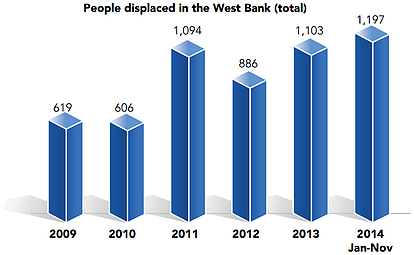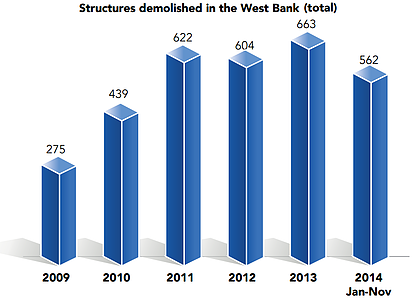Record number of displacements due to West Bank demolitions in 2014
Concern over ongoing practice of punitive demolitions
During November, the Israeli authorities demolished or removed a total of 48 Palestinian-owned structures across the West Bank, including East Jerusalem. All but one structure were demolished on the grounds of lack of a building permit. In total, 136 people were displaced, half of them children. While the number of structures demolished this month is slightly below the monthly average recorded in the previous ten months of 2014, the number of displaced people is higher. The cumulative number of people displaced so far in 2014 is nearly 1,200, the highest such figure recorded by OCHA in an entire year since it began tracking this indicator in 2008.

East Jerusalem
Eleven structures, including seven residences, were demolished in East Jerusalem and around 30 people were displaced. Three of these houses were demolished by their owners to avoid paying the fine they would be charged for demolition by the Israeli authorities.
Another house was demolished in Silwan on 19 November on punitive grounds, citing security and deterrence needs, and resulted in the displacement of seven people. The residence belonged to the family of a 20-year-old Palestinian who ran over Israeli pedestrians at a light rail station in East Jerusalem on 22 October, killing an infant and a woman, before he was killed by Israeli forces. Five other families in East Jerusalem have been served with similar demolition orders.
On 3 December, the Humanitarian Coordinator for the OPT issued a statement highlighting the illegality of punitive demolitions and calling for an immediate freeze of this practice. Also this month, seven Israeli human rights organizations filed a petition with the Israeli High Court of Justice challenging the legality of the practice and demanding its suspension (see below).
Area C
The remaining 37 structures demolished this month were in Area C, around 60 per cent of them recorded in the Jordan Valley. The community most affected was Bardala (Tubas), where 13 residences and two livelihood structures were demolished, displacing around 40 people. While only a very small part of this community is in Area C (the bulk is defined as B), residents are highly vulnerable due to the proximity of this area to a military “firing zone”. The remaining demolitions took place in four Palestinian Bedouin communities in Qalqiliya, Jericho, Hebron and Ramallah governorates.
Six of the affected structures were donor-funded, including a recently renovated agricultural road and a water connection under construction in a Jordan Valley community, Tell al Khashabah, located within a military “firing zone”.
The Israeli authorities also delivered demolition and stop-work orders against 12 donor-funded residential structures in the Bedouin community of Wadi Beit Hanina in the Jerusalem governorate, and requested an implementing agency to remove five others in Khashem al Karem community (Hebron). Since the latter structures have demolition orders pending, the request may indicate that their demolition is imminent.

The illegality of punitive demolitions
* This section is based on contributions from the Norwegian Refugee Council and the Office of the High Commissioner of Human Rights.
The Israeli authorities refer to a provision in the Emergency Defence Regulations of 1945 enacted by the British Mandate in Palestine as a purported legal basis for punitive demolitions. The alleged rationale is that such demolitions deter potential perpetrators from carrying out attacks and may encourage family members who are aware of a future attack to try and prevent it. The effectiveness of punitive demolitions as a deterrent has been questioned, including by an Israeli military committee that recommended suspension of this practice in 2005.
The destruction of private property in an occupied territory is prohibited under international humanitarian law (IHL), unless “such destruction is rendered absolutely necessary by military operations”.[1] Punitive demolitions do not fall within this exception. Punitive demolitions are also a form of collective penalty prohibited under IHL as they target the family members of a perpetrator, or alleged perpetrator, who are not involved in the alleged acts.[2]
Additionally, depending on the specific circumstances, this practice runs counter to a range of rights and protections embodied in various international legal instruments that are legally binding on Israel. These include the right to a fair trial and due process, including the presumption of innocence; the prohibition on cruel, inhuman and degrading treatment or punishment; the right to property; the right to adequate housing and to choose one’s residence; the prohibition on forced evictions; the prohibition on forcible transfers; and the right not to be subjected to arbitrary or unlawful interference in one’s privacy, family or home.









